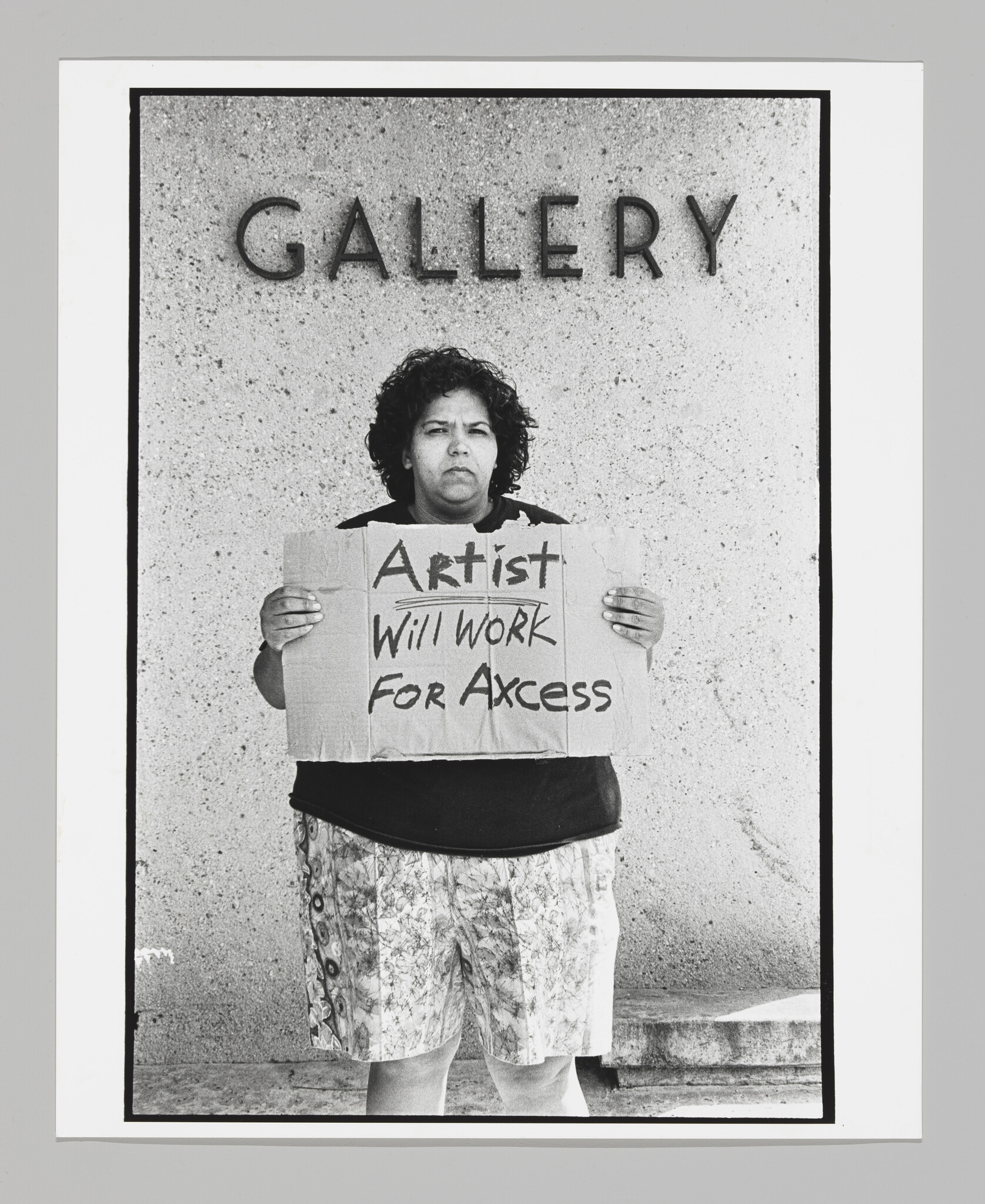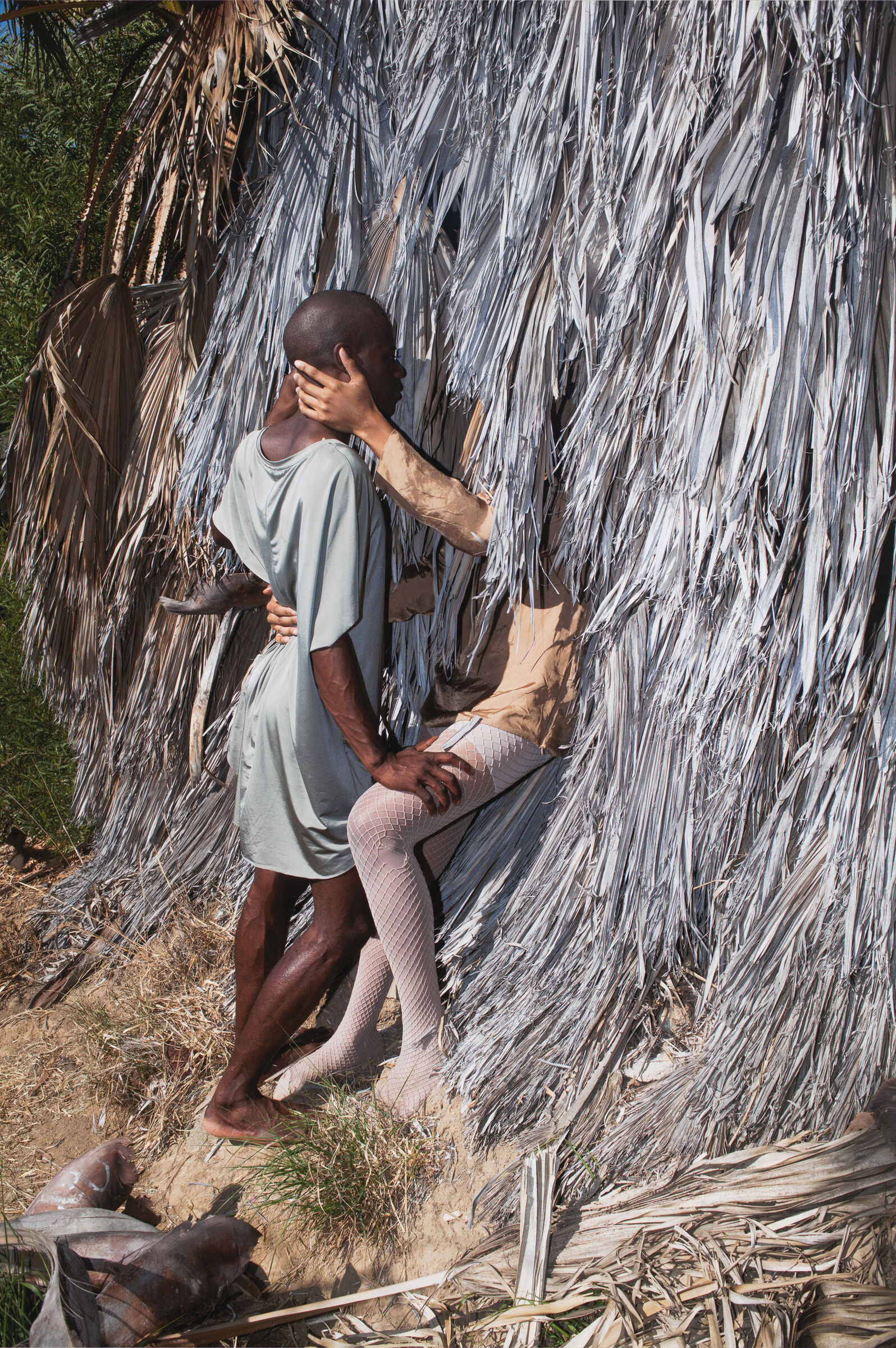Visual description
Will Work For #4 is a black and white photograph that is almost 20 inches tall and almost 16 inches wide. The photograph is a self-portrait in which the artist, Laura Aguilar, stands alone in the center of the frame, with her body visible from her knees up. She is a self-described fat Chicana woman with shoulder-length curly black hair, wearing a dark T-shirt and patterned knee-length shorts. She holds a cardboard sign that reads “artist will work for axcess” in front of her chest with both hands. The text of the sign is hand scrawled in thick black lines, which are slightly rippled due to the surface of the cardboard. The word “artist” is underlined with an emphatic zigzag, and the word “access” is misspelled, with an “x” replacing the first “c”–a reference to Aguilar’s dyslexia. The sign itself has several creases and a rough, torn upper edge.
Aguilar stands in front of a rough speckled stone wall, seemingly outside of a building. The word “gallery” is on the wall in sleek metal lettering, sitting just above Aguilar’s head. The font is clean, and because the letters are fixed to the wall, the sign feels official and permanent. This stands in stark contrast to the messy handwritten text on Aguilar’s sign. The artist used this contrast to highlight how she often felt like an outsider in the mainstream art world as a fat Chicana lesbian who struggled with depression, intense shyness, and dyslexia. In the bottom left corner of the photograph, a patch of sunlight shines onto a singular step. It suggests that the photograph was taken in the afternoon, perhaps in Los Angeles, where she lived and worked. Her facial expression has a serious but calm tone. Her eyes squint slightly as she furrows her eyebrows, and her mouth turns downwards at the corners.
In standing outside of a building marked “gallery” and holding a sign that reads “artist will work for axcess,” Aguilar protests the exclusivity of the art world. Aguilar gained little commercial success during her life, which spanned from 1959 to 2018. It was not until a 2017 retrospective in Los Angeles that her work became more popularly recognized. In Will Work For #4, the artist works as both sitter and artist. By using the camera to emphasize her own marginalized identities, Aguilar critiques the inaccessibility of the commercial art world.
Not on view
Date
1993
Classification
Photographs
Medium
Gelatin silver print
Dimensions
Sheet: 19 7/8 × 15 15/16 in. (50.5 × 40.5 cm)
Image: 19 × 12 7/8 in. (48.3 × 32.7 cm)
Accession number
2019.394
Series
Will Work For
Edition
Unique
Credit line
Purchase, with funds from the Director's Discretionary Fund
Rights and reproductions
© Laura Aguilar Trust of 2016
Audio
-
0:00
Verbal Description: Laura Aguilar, Will Work For #4, 1993
0:00
Narrator: Will Work For #4 is a black and white photograph that is almost 20 inches tall and almost 16 inches wide. The photograph is a self-portrait in which the artist, Laura Aguilar, stands alone in the center of the frame, with her body visible from her knees up. She is a self-described fat Chicana woman with shoulder-length curly black hair, wearing a dark T-shirt and patterned knee-length shorts. She holds a cardboard sign that reads “artist will work for axcess” in front of her chest with both hands. The text of the sign is hand scrawled in thick black lines, which are slightly rippled due to the surface of the cardboard. The word “artist” is underlined with an emphatic zigzag, and the word “access” is misspelled, with an “x” replacing the first “c”–a reference to Aguilar’s dyslexia. The sign itself has several creases and a rough, torn upper edge.
Aguilar stands in front of a rough speckled stone wall, seemingly outside of a building. The word “gallery” is on the wall in sleek metal lettering, sitting just above Aguilar’s head. The font is clean, and because the letters are fixed to the wall, the sign feels official and permanent. This stands in stark contrast to the messy handwritten text on Aguilar’s sign. The artist used this contrast to highlight how she often felt like an outsider in the mainstream art world as a fat Chicana lesbian who struggled with depression, intense shyness, and dyslexia. In the bottom left corner of the photograph, a patch of sunlight shines onto a singular step. It suggests that the photograph was taken in the afternoon, perhaps in Los Angeles, where she lived and worked. Her facial expression has a serious but calm tone. Her eyes squint slightly as she furrows her eyebrows, and her mouth turns downwards at the corners.
In standing outside of a building marked “gallery” and holding a sign that reads “artist will work for axcess,” Aguilar protests the exclusivity of the art world. Aguilar gained little commercial success during her life, which spanned from 1959 to 2018. It was not until a 2017 retrospective in Los Angeles that her work became more popularly recognized. In Will Work For #4, the artist works as both sitter and artist. By using the camera to emphasize her own marginalized identities, Aguilar critiques the inaccessibility of the commercial art world.


